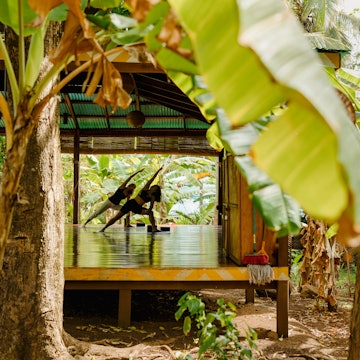
The Lonely Planet guide to London’s Natural History Museum and Science Museum

Jul 14, 2025 • 12 min read
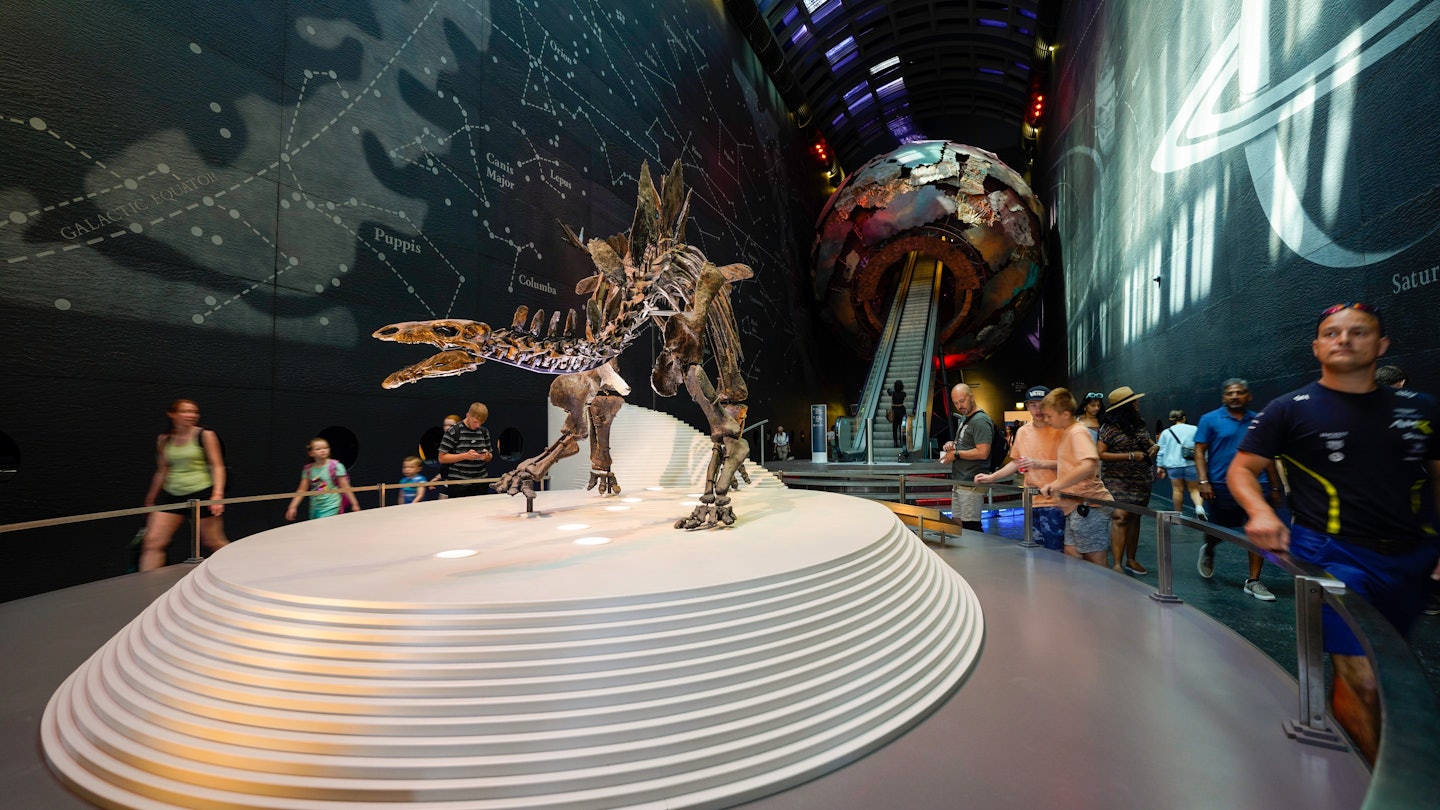
The Natural History Museum is one of London's top stops for families. Old Town Tourist/Shutterstock
While the Victoria & Albert Museum (V&A) is South Kensington’s landmark institution, families make a beeline for the nearby Natural History Museum and Science Museum. These temples to knowledge have been entertaining and educating Londoners for over a century, and many locals feel a personal connection to both as a result of childhood school trips.
The Natural History Museum is the superstar venue, with stuffed specimens and skeletons from hundreds of species and the country’s most impressive collection of dinosaur skeletons. The Science Museum has special appeal for budding physicists and engineers – though every visitor will enjoy the displays of spacecraft, planes and early tech, including some of the first steam trains.
Set side by side on Exhibition Rd, both sites can be counted among London’s best museums, particularly with kids in tow. There are buttons to press, levers to pull and fun organized activities. Interactive experiences include the Natural History Museum’s earthquake simulator and the Science Museum’s Wonderlab, and you’ll have to drag kids away from the well-stocked gift shops.
Discover more with this guide to London’s Natural History Museum and Science Museum.
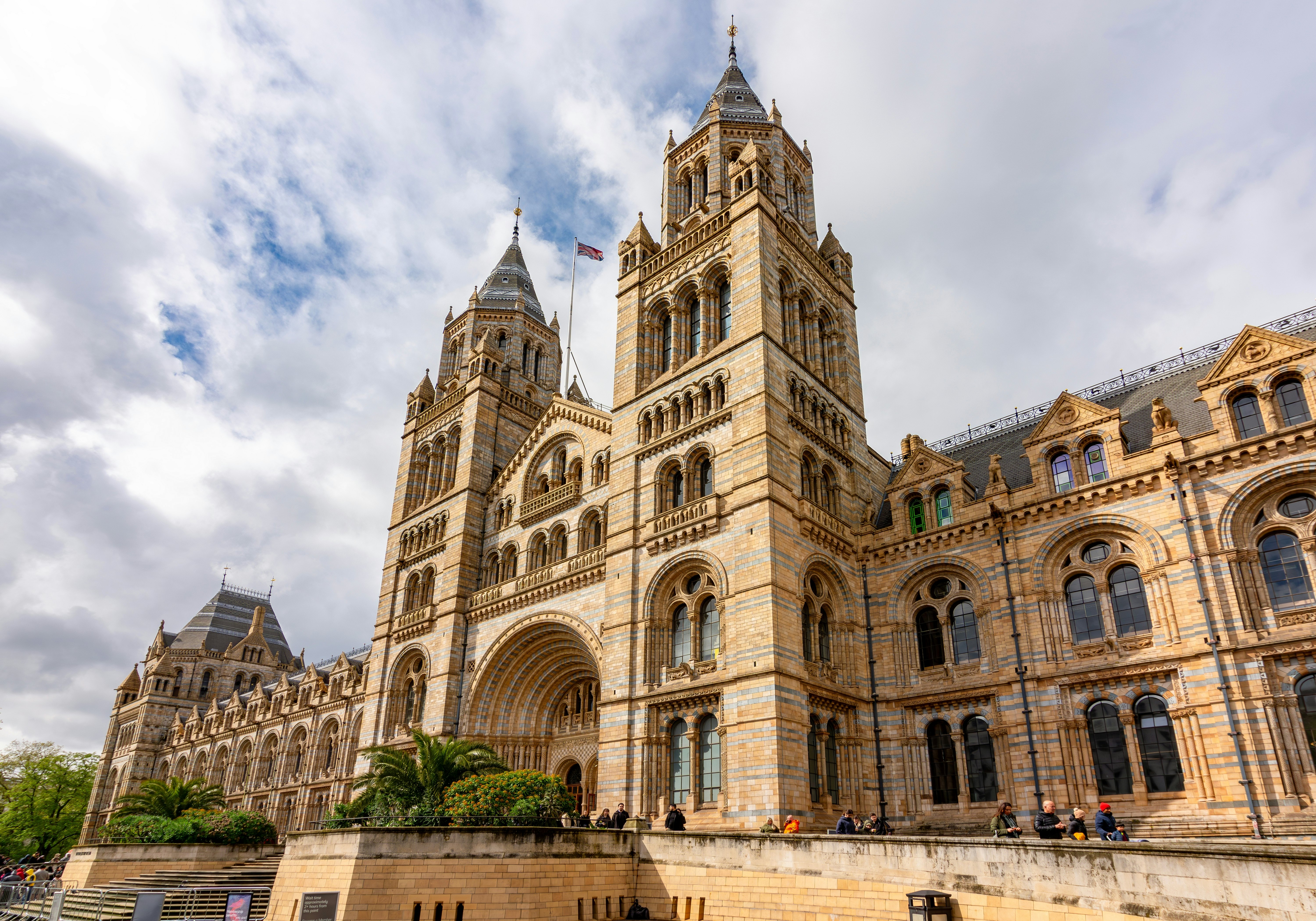
What is the history of the Natural History Museum and Science Museum?
The opening of the V&A in 1857 was followed by the grand opening of the Natural History Museum in 1881. The original design for the building was developed by Irish engineer Captain Francis Fowke; since he died a year later, his plans were expanded by Alfred Waterhouse, a committed devotee of the Gothic Revival style.
Waterhouse graced his grand new museum with soaring towers and cathedral-like arches, adding a riot of embellishments using terracotta tiles in place of carved stone – a more durable material when faced by the corrosive smog of Victorian London. The tiles were sculpted by French artist Dujardin, following Waterhouse’s hand-drawn designs.
Inside and out, the museum is covered in quirky depictions of plants, animals, birds and marine life; a terracotta menagerie of wolves, lions, saber-toothed cats and pterodactyls guards the parapets along the facade. Indeed, the tile work is almost as interesting as the specimens in the display cases inside.
The Science Museum is the newest kid on the block (though parts of its collection were once displayed in the V&A). The museum became a separate institution in 1909, and its imposing Portland stone home on Exhibition Rd took shape over the next two decades, with construction held up by WWI. The completed museum fully opened to the public in 1928.
When should I visit the Natural History Museum and Science Museum?
The Science Museum is open daily from 10am to 6pm, with the last entry at 5:15pm. The Natural History Museum opens daily from 10am to 5:50pm, with the last entry at 5:30pm. Some times are busier than others, so it pays to plan the timing for your visit carefully.
Summer weekends and school holidays can see huge crowds and massive entry queues, while term-time lunchtimes get busy with school groups. For the quietest experience, come early in the morning or later in the afternoon on a weekday during term time. Always check the schedule of special exhibitions and events before you come.
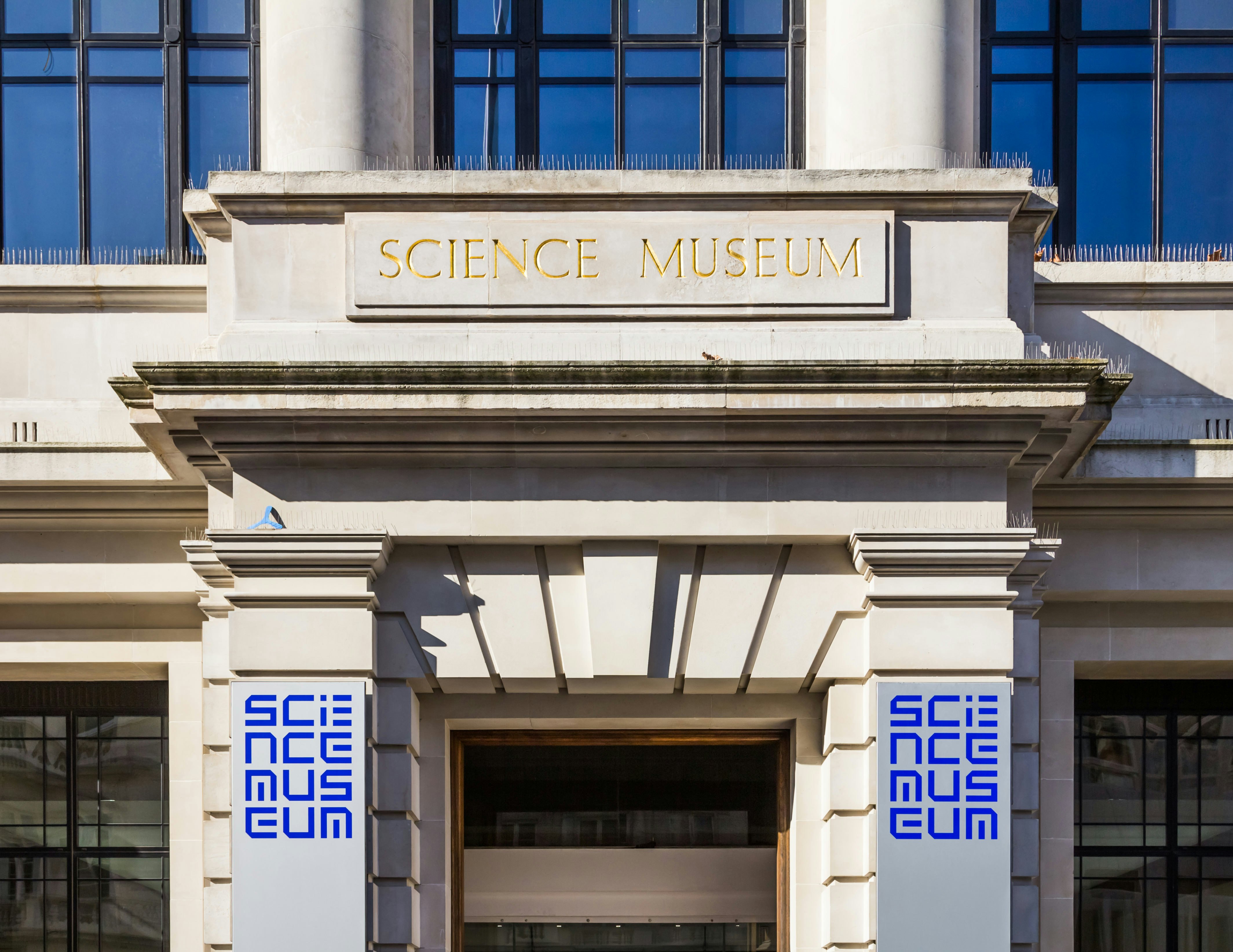
How much do tickets cost?
The Natural History Museum and the Science Museum are free to visit, but donations help support the museums’ huge operating costs. Signs at both museums suggest donating £5 (US$6.80) per person – a bargain compared to most museums around Europe.
What should I eat and drink on a trip to the museums?
The Natural History Museum and Science Museum have on-site restaurants with kiddie-friendly menus and cafes for drinks and snacks – though costs can mount up, particularly if you add drink and cake stops to the equation. Consider cutting your overhead by bringing a picnic.
The Natural History Museum has a big picnic area in the basement in the Green Zone, though it’s reserved for school groups from 11am to 2pm on weekdays in term time. Alternative picnic spots include the Darwin Centre Courtyard and nearby Hyde Park (at the end of Exhibition Rd). In the Science Museum, head to the lower-ground-floor picnic area, or munch in the seating areas on Level 1 and Level 3.
For restaurant eats, head to the south end of Exhibition Rd around Thurloe Pl. You’ll find Thai, Lebanese, Chinese, Italian, Spanish tapas and other world foods, plus ice cream and plenty of fast food around South Kensington Tube station (including a Pret a Manger). Also here is Daquise, a charmingly old-school Polish restaurant that has been dishing out pierogi since 1947.

What are the must-sees at the Natural History Museum in London?
About five million people visit this collection of 80 million specimens every year, and you’ll want to set aside half a day to explore. Check the website for upcoming events – held from October, the ticketed annual Wildlife Photographer of the Year exhibition is one of the biggest shows on the calendar.
Admire the grand Hintze Hall
The museum’s grand Hintze Hall resembles a cathedral nave – fittingly, as it was built in a time when natural sciences were challenging Christian ideas about the divine creation of life on earth. Named after a generous donor, it features an ornately tiled floor, arched doorways, ornate columns, sculpted animals scuttling up its walls and a grand staircase at its center, backed by huge stained-glass windows.
On the hall’s intricate ceiling are 162 hand-painted panels depicting plant species from across the globe. Yet your eye will be first grabbed by the enormous skeleton of a blue whale, recovered from the coast of Ireland in the 1890s. Diving down from the ceiling, this 25m-long (82ft) leviathan was installed in 2017, replacing “Dippy” – the cast of a Diplodocus skeleton, which greeted visitors for most of the last century.
Other exhibits around the hall include an American mastodon, a rock as old as the solar system and a pickled Atlantic blue marlin – just a taste of the wide-ranging exhibits in the galleries beyond. Note the white marble statue of Darwin sitting, sage-like, on the central stairway.
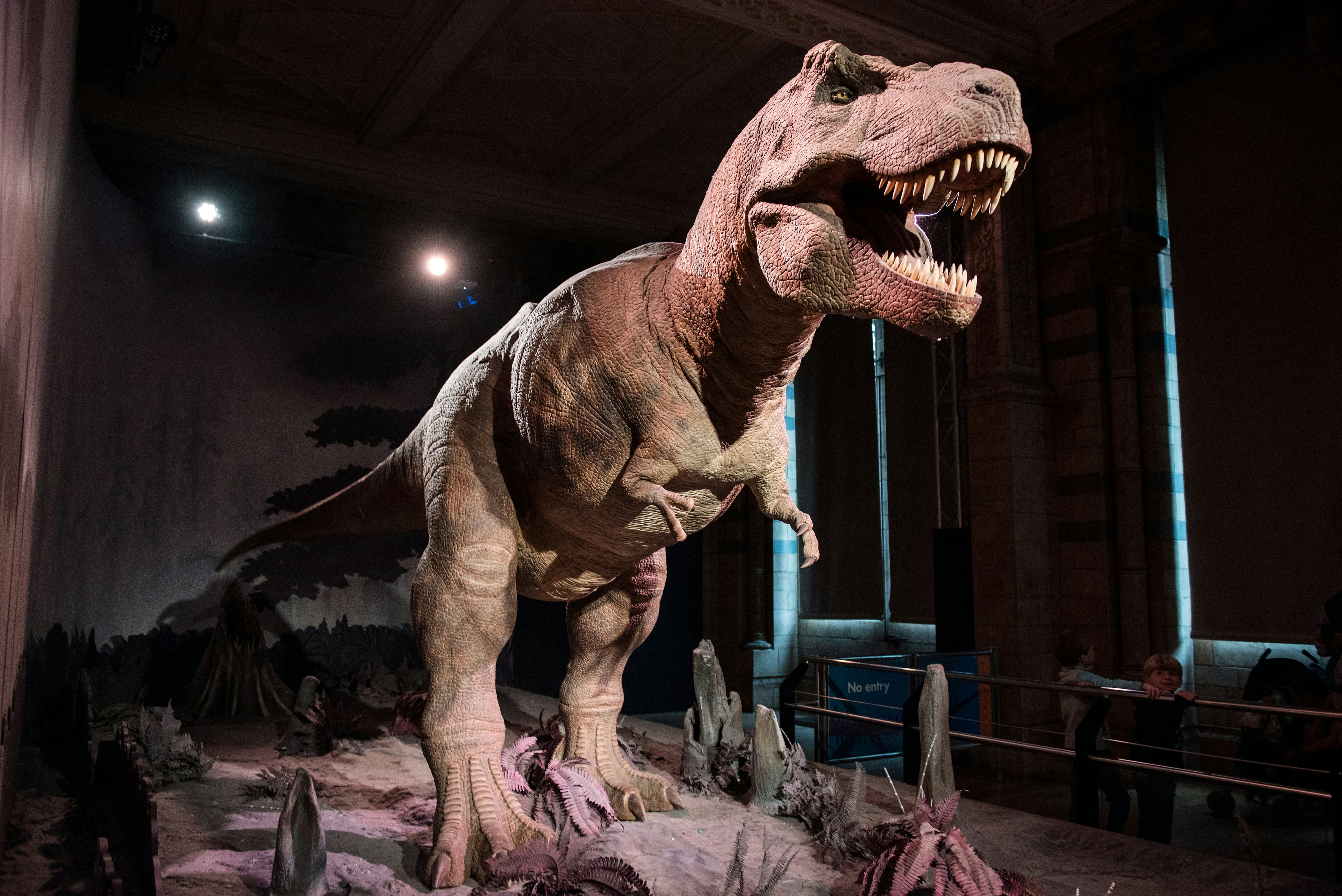
Meet prehistoric giants in the Dinosaurs Gallery
You’ll hear the squeals of excited children from outside this popular gallery, as visitors come face-to-face with a lifelike, roaring animatronic Tyrannosaurus rex. Beyond, you can view a whole Triceratops skull, part of the first-ever Tyrannosaurus rex skeleton ever discovered, assorted Iguanodon remains and a Scolosaurus with an armored shell and club-like tail.
The remainder of the Blue Zone is devoted to skeletons, models and taxidermy specimens of mammals, fish, amphibians and reptiles. Key exhibits include a model blue whale swimming among dolphins and porpoises, big cats, elephants, rhinos, hippos and polar bears. Look out for the extinct saber-toothed cat and duck-billed platypus, and duck into the dedicated dinosaur gift shop.
Get shaken by an earthquake in the Red Zone
To explore the Red Zone, take an escalator up through a glowing red planet to reach galleries devoted to rocks, volcanoes, earthquakes and tectonic activity. Pep up travelers with flagging energy levels by visiting the earthquake room – a juddering simulation of a grocery store hit by the 1995 earthquake at Kobe in Japan. You’ll also find gems and minerals in every imaginable color and configuration.

Discover quirky nature in the Green Zone
Featuring 22 remarkable objects dating back as far as 4.6 billion years, the Cadogan Gallery in the Green Zone has some of the rarest treasures ever put on display. Items range from a piece of moon rock to the skull of a Barbary lion from the medieval zoo in the Tower of London and a rare first edition of Charles Darwin’s On the Origin of Species.
Other Green Zone galleries feature fossils, minerals, birds and creepy crawlies. One undisputed highlight is the collection of fossil marine reptiles gathered by pioneering female paleontologist Mary Anning on England’s Jurassic Coast, featuring long-necked plesiosaurs and dolphin-like ichthyosaurs, with their “pineapple ring” eye bones.
Also worth your time are the Vault, home of the Aurora Pyramid of Hope, a collection of almost 300 colored diamonds; and the Minerals Gallery, displaying specimens in their original Victorian wooden cases.
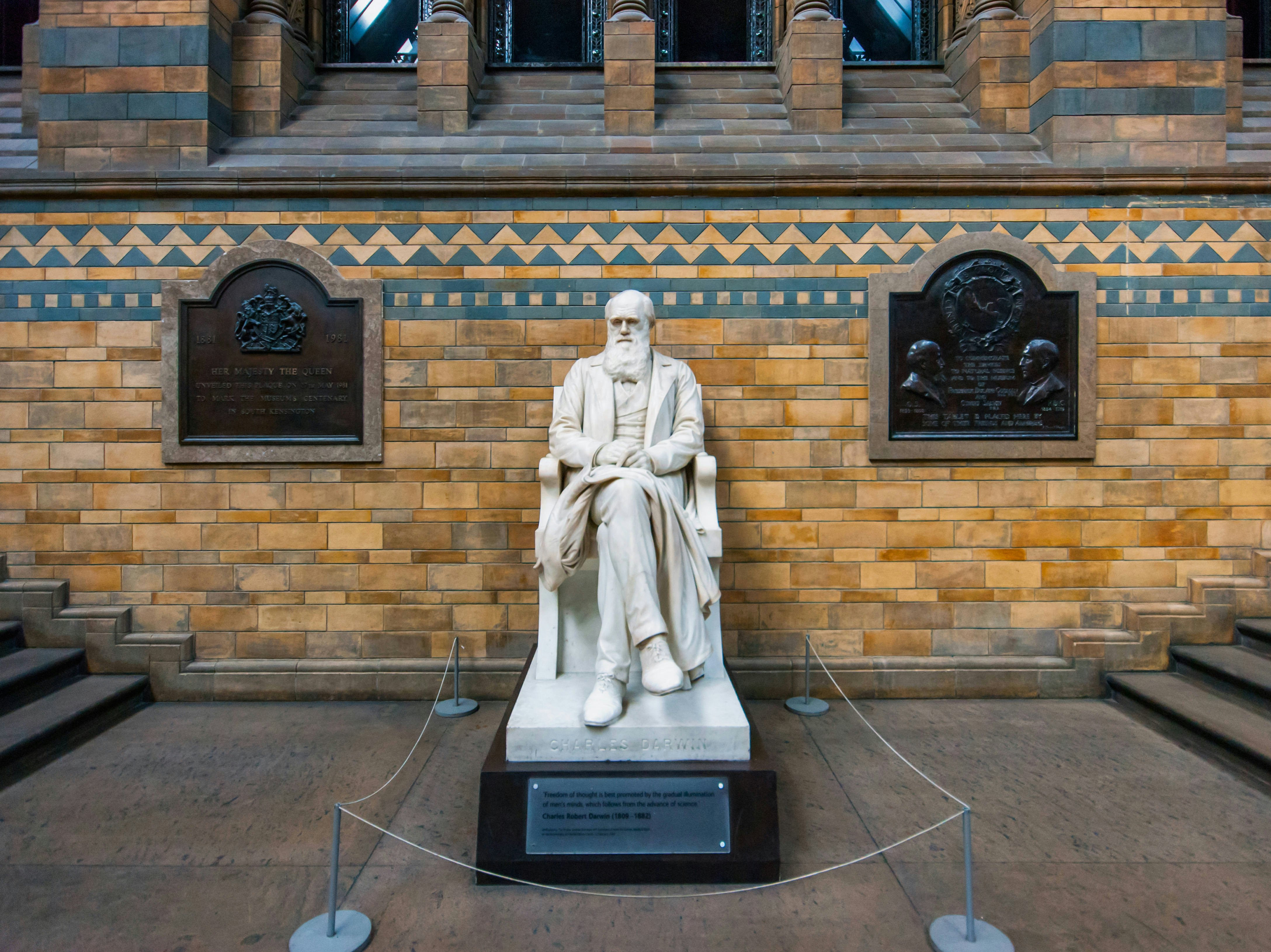
See the science behind the exhibits at the Darwin Centre
Completed in 2009, the Darwin Centre is where the museum’s 300 scientists and research staff study the specimens; visitors can watch them through big glass windows. Yet the main attraction is peeking at the collection of 20 million pickled specimens, including an octopus collected by Charles Darwin in Cape Verde in 1832. The garden outside the Darwin Centre is a good place to catch your breath before you head to the next exhibit.
Have a sleepover at the museum
On select nights, the museum holds Dino Snores – special overnight sessions for parents and children – that allow guests to roam around the museum at night without the crowds. Later, you’ll bed down for the night in Hintze Hall. The museum provides a mat but you’ll need to bring a sleeping bag, toothbrush and pajamas.
At adults-only Dino Snores events, there’s a bar and a three-course meal, plus activities ranging from animal encounters and stand-up comedy to a science show and a monster movie marathon. Also look out for silent disco nights and other grown-up evening events – see the website for listings.
Take a natural history tour
The museum has a busy schedule of free and paid-for tours. The fascinating (and free) Diverse History of Science tour follows the endeavors of pioneering female scientists, including giraffe expert Anne Innis Dagg, and Kathleen Lonsdale, who helped establish the science of crystallography. Paid-for tours on fixed dates visit the highlights of the museum and go behind the scenes to view unseen parts of the collection. See the museum website for details.
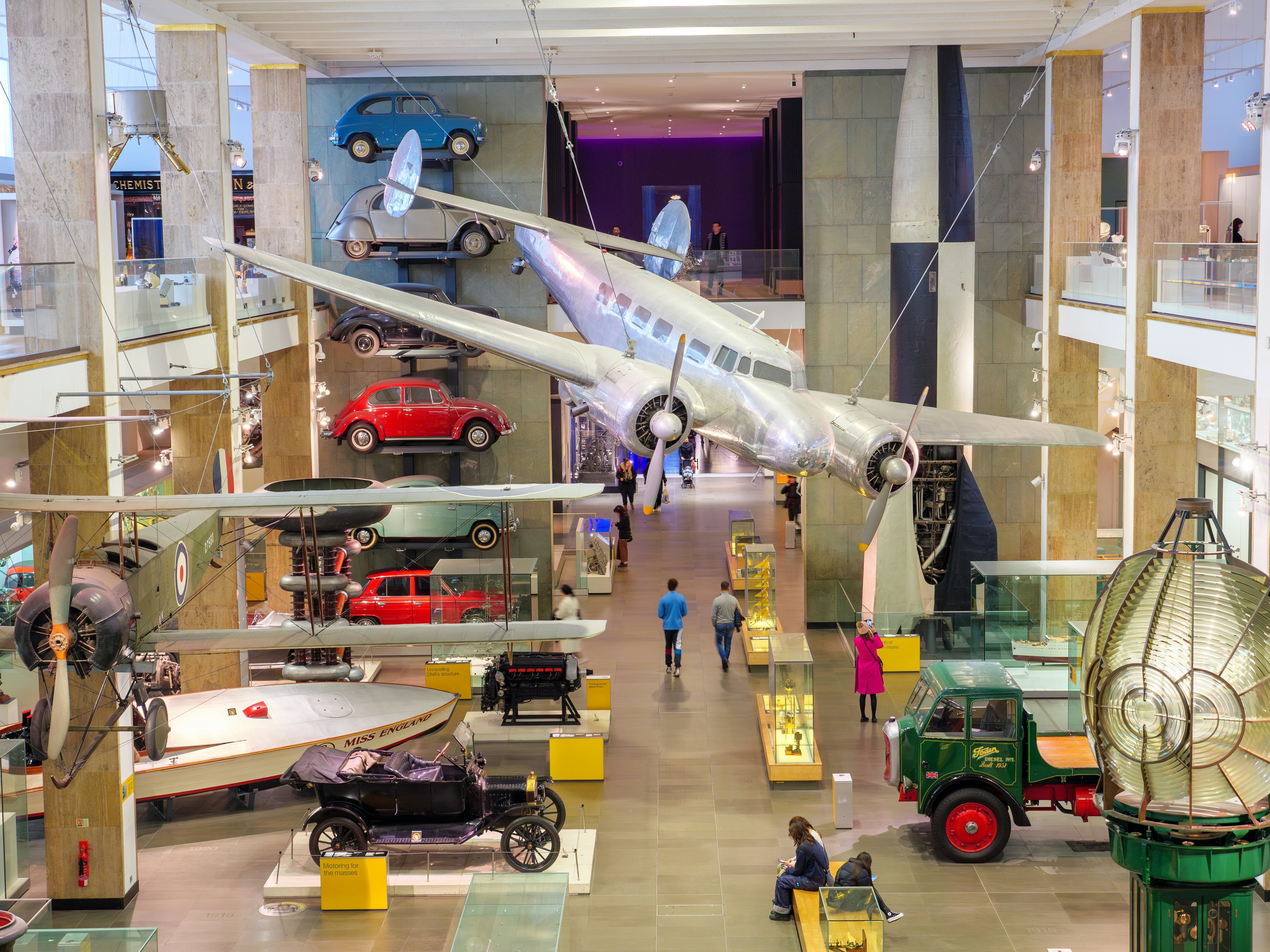
What are the must-sees at the Science Museum in London?
Next door to the Natural History Museum, the Science Museum will easily fill another half day of your time. While it’s hugely popular, school holiday queues are a little less overwhelming than at the Natural History Museum; pre-book a pre-timed slot to skip past the general queue. As you go in, ask about free talks and tours.
Learn about the age of steam
The first area you’ll reach is the Energy Hall, full of enormous steam-powered machines from the golden age of heavy industry; some of the hulking engines are periodically fired up for demonstrations. As you leave the Energy Hall for the space zone past a collection of vehicles from across the industrial age, note the vast German V2 missile from WWII – a stepping stone toward the rockets that carried astronauts to the moon.
Take a trip to space
The ever-popular Exploring Space gallery closed in June 2025, but a new exhibition on space travel is set to open before the end of the year. You can expect to see the return of such landmark exhibits as the Apollo 10 command module and the Soyuz TMA-19M spacecraft that carried Tim Peake, Yuri Malenchenko and Tim Kopra to the International Space Station in 2015.
The collection also includes prototype rockets and astronomical instruments from the early days of investigating the heavens, such as a 13th-century astrolabe and Galileo Galilei’s 1610 refracting telescope, used in early observations of the moon.
The Making the Modern World exhibition showcases all manner of early machines, from a 1845 Grand Junction Railway locomotive to one of the first X-ray photographs, taken in 1896.
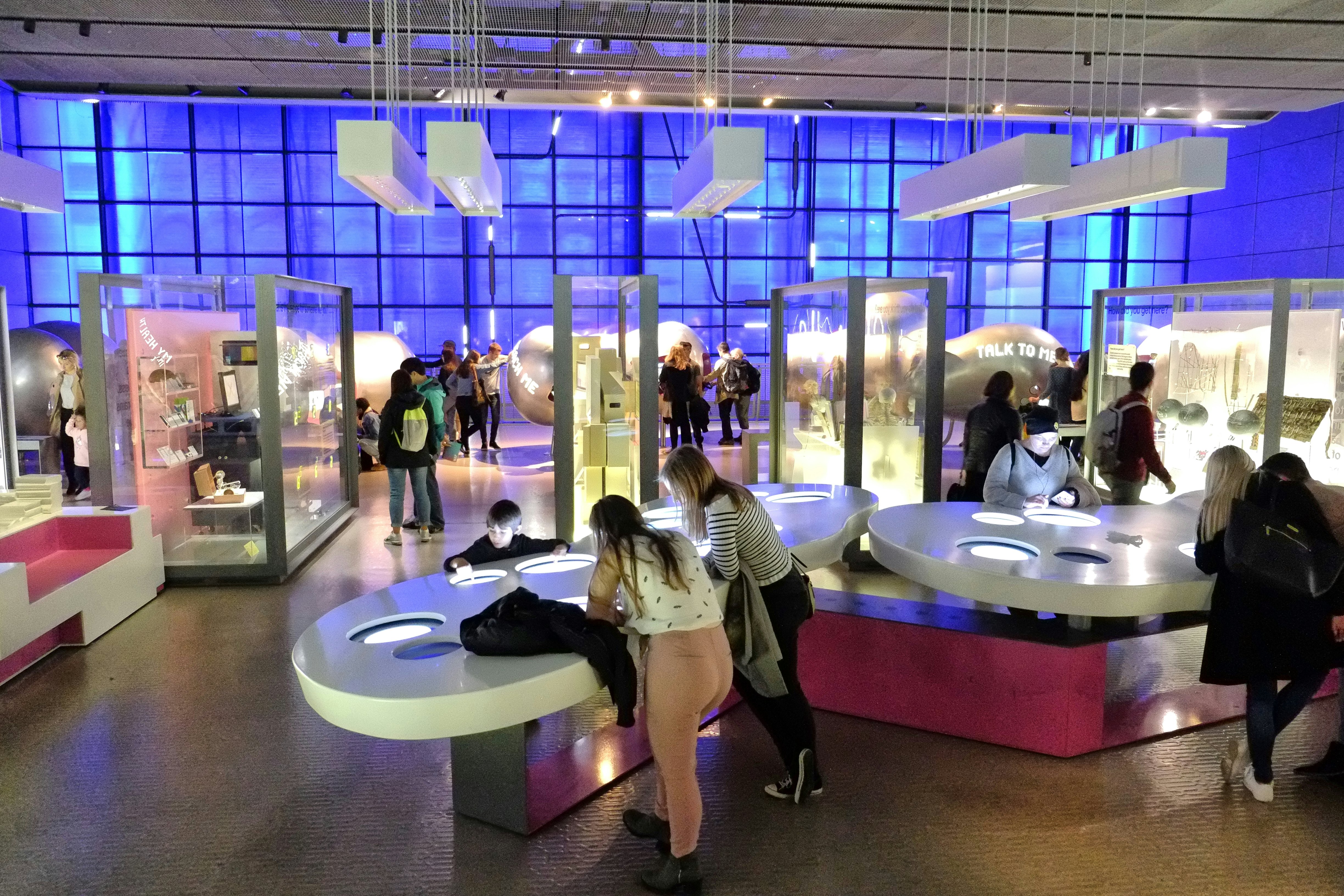
Discover the science of medicine
On Level 1 are the medicine-focused Wellcome and GSK Galleries, containing 3000 remarkable objects from the history of health care, including early dissecting tools, a gruesome operating table, prosthetic limbs and exhibits on life-saving penicillin. Interactive machines on the rear mezzanine level let you explore genetics.
Look out for quirky items such as Theodore Roosevelt’s medicine chest, which the 26th US president took on safari in 1909. Continue through the exhibition hall to see how faith has played a huge part in medicine and view objects used in traditional healing rituals, including masks, amulets and charms.
Unravel the science of math and information technology
Highlights of Level 2 include the Mathematics gallery, where you’ll learn how numbers and calculations allowed for scientific breakthroughs and the discovery of new continents. In the Zaha Hadid–designed Winton Gallery, don’t miss the WWII Enigma coding machine and the difference engine – a primitive mechanical computer used by the insurance industry in the 19th century to assess the likelihood of policyholders dying.
In the Science City gallery, frank displays discuss the role of slavery and colonization in scientific discovery, while the Information Age gallery is all about computers, television, radio, and the internet. Don’t miss the Clockmakers’ Museum – a treasure trove of vintage timepieces, including John Harrison’s fifth marine chronometer, which helped sailors solve the problem of longitude.
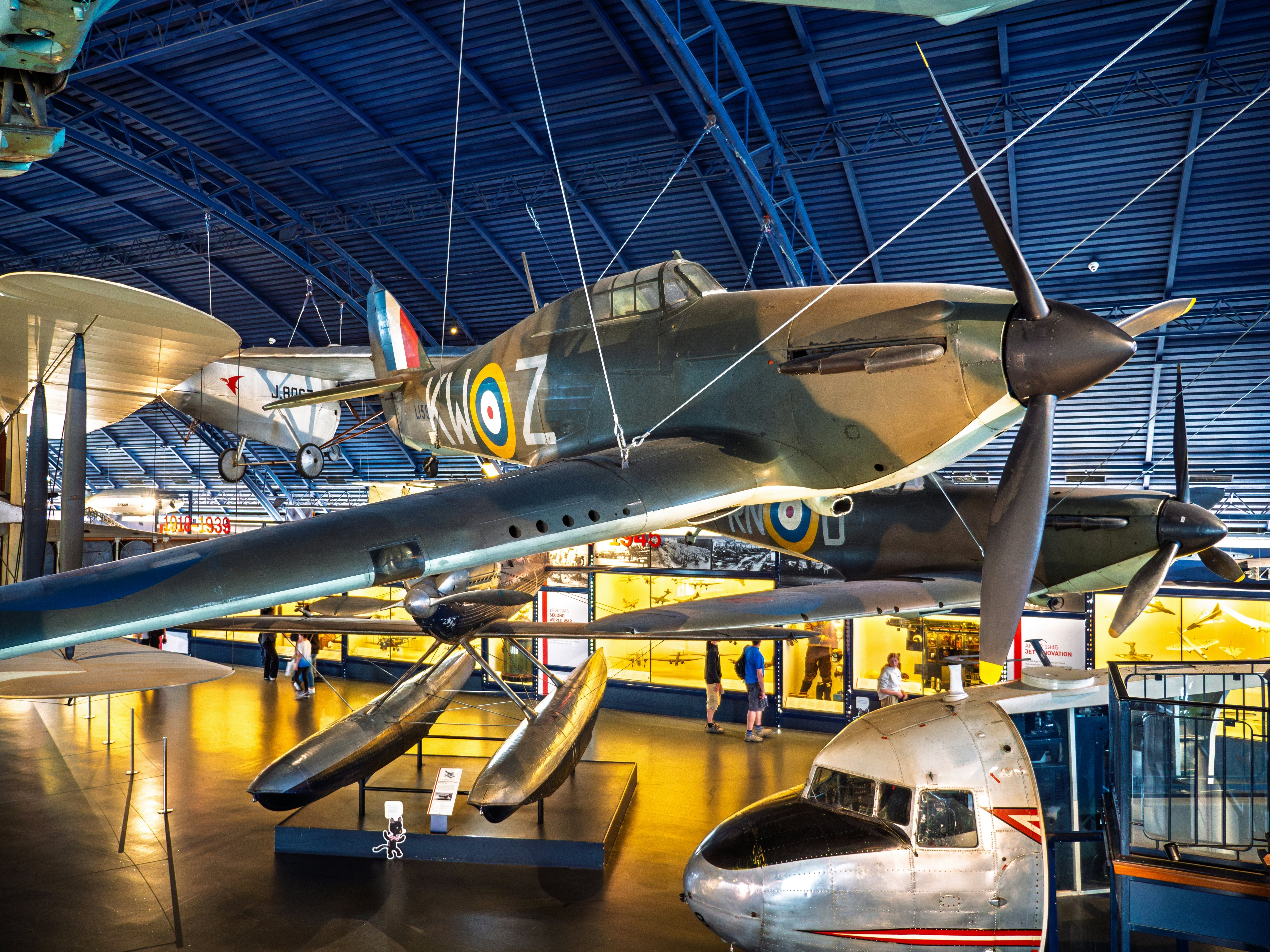
Unleash your inner plane spotter on Level 3
On Level 3, you can get within touching distance of planes, jet engines and other excitingly analogue technology from the history of powered flight. Highlights include a cross section of a Boeing 747 jumbo jet, Amy Johnson’s Gipsy Moth, and a Vickers Vimy that crossed the Atlantic in 1919. Other displays explore the journey of early flight pioneers such as the Wright brothers.
Get experimenting at the Wonderlab
There’s an additional fee of £15 (US$20.60) per person to enter the Wonderlab on Level 3 – and it’s an excellent investment for kids ages seven to 14. You can watch demonstrations, including the firing up of a giant Van de Graaff generator, and get hands-on with dozens of intriguing science experiments involving energy and physical principles – all highly educational fun.
Get your game on in the basement
Down on the basement floor, you’ll find the Garden, a free interactive space for kids under six years, with tons of sensory activities, from experiments with the power of water to climbing frames and giant building blocks.
Older kids will be more interested in Power Up, a retro gaming den where can can play vintage computer games on various generations of consoles and operating systems, and join a 16-person Halo shoot-em-up. An all-day pass costs £12 (US$16.50).
Then there are the IMAX screens and simulators dotted around the museum, which offer the chance to travel back to prehistoric times, experience flying in a fighter jet and other thrills (for an extra cost). With kids in tow, a visit to the well-stocked, science-oriented gift shop near the Energy Hall on Level 1 is almost obligatory.
Are the Natural History Museum and Science Museum accessible?
At the Science Museum, ramps, elevators and accessible toilets put everything within easy reach, including the top-floor Wonderlab and basement Power Up gaming zone, and there are wheelchairs and folding stools to borrow.
The Natural History Museum has also done a good job of making its historic building accessible, with ramps, elevators, accessible toilets and wheelchairs you can borrow. To avoid the obstacle of the grand central staircase in Hintze Hall, elevators will take you to every floor.
This article was adapted from Lonely Planet’s London guidebook, published in June 2025.








